 |
|
|
|
|
|
Commentary by Rick Kleffel
The Agony Column for March 26, 2003
See if this sounds familiar. You're crabby, tired, tired of working. Tired of cleaning the house, tired of going to work, tired of whatever is on the tube, tired of the very world that surrounds you. There's only one real way to shut that out, only one way to pull the plug on reality, and that's to read. But the world is pretty much with whatever is available on the fiction bookshelves as well. I admit it; these are the times that try men's souls. Typically, that means I want to escape reality.
 |
|
|
Now, obviously, one can't really escape reality. One must send it checks on a monthly basis. It responds with crisis of the moment updates. But reading a good book means making the world go away in a very special fashion. When reading we're forced to reconstruct the world that is written about in our heads. By virtue of its very nature, reading excludes reality. But in re-constructing a created reality in our minds through reading, we are given a forceful insight into how our minds re-construct the reality around us, how our input influences our picture of the world. In a sense, nothing could be more relevant than fantasy fiction. Fantasy is probably one of the main reasons I read, but the typical fantasy is one of the reasons I stopped reading speculative fiction for a time. I'm sorry, but looking at the leather clad guys on the shelves of books from the seventies through the nineties, all I could hear was Peter Grave's cultured voice asking "Do you like gladiator movies?"
But as with all genres and subgenres, there's a sort of spectrum of stuff that's actually good, and covers a wide enough range to help you pass the time between fixes of reality from the mailbox and bozo box. I've taken it upon myself to read across that range, look for the good material and report back to you how you can journey from hyper-violent fluff the hyper-meaningful folds of space and time and still claim to be reading something remotely resembling fantasy. This is fantasy you can read that you won't have to hide behind your Emily Bronte novels, fantasy from which you will not have to tear the covers off the paperback. One of my friends actually does this, so that people won't know he's reading 'The Gladiatrix of Mantissa'. Hey, it's a math treatise. You want your reading rainbow? I've got your reading rainbow. I must admit that some of my fondest memories of bring up the kids revolve around this show. So it's no surprise when I visit it ten years later.
 |
|
The Hollowood screenwriting process in action. Here's where the next set of fantasy-based movies is coming from. This is actually from the cover of a very old LP by the Mekons titled 'The Quality of Mercy is not strnen'. (No typo on my part.) |
Now the term 'fantasy' could be easily stretched so that it was congruent with 'fiction'. The marketing department of just about every house that used to publish horror would have you believe that all those new novels about blood drinking vampires and throat-slashing monsters are "dark fantasy", but I'm not buying it. When I say fantasy here, for the most part, I mean good old leather-diaper clad muscle-bound strongmen on horses riding to the rescue of vixens in rawhide string bikinis. I mean slack-jawed, drooling dumbed-down swords and sorcery featuring sexist heroes, sexy heroines and a cadre of height-challenged sidekicks with an Associate Degree in mumbo-jumbo magic. The kind of fiction that happens when you lock three advertising executives in a room with 'Lord of the Rings', a display showing the ever-increasing profit margin from the three films, books and all their associated merchandising, and a monkey to man the typewriter.
Well, no, I don't mean this kind of fiction. There's a lot of it about, make no mistake. It sells like hotcakes. At least prominent display space and ample advertising would suggest so. That's good, because it subsidizes the kind of stuff I really like. And I myself know that every once in a while, one needs some sort of reading that will absolutely, without doubt prevent any rational thought. But it's possible to achieve this state of fantasy-reading bliss without resorting to the likes of Those Who Shall Not Be Named. Just as there is a Spectrum of Space Opera, there is a Fantasy Rainbow of quality fiction that happens, on occasion, to involve men in leather diapers mixing it up with scaly nemeses. But in an artistic, meaningful sort of fashion. Call it Swords and Subtlety. The edges of the spectrum have not changed for years, but the shadings in between have become increasingly worth reading.
|
|
|
|
|
|
|
|
|
|
|
The Lord of the Rings |
PETA beware their love of fur! |
Not only the sidekicks are small! |
Hollowood hardbodies. |
Even the small swords are deadly |
The Seriously Scholarly Standard. |
Inventing languages. |
|
|
Chronicles of the Raven |
Made from the finest Corinthian leather. |
Sidekicks don't last in this world. |
(1) mud-fisted barbarian, (1) toned gladiator. |
No named swords. |
Clint Eastwood in a jerkin. |
Killing characters you know and love. |
|
|
Malazan Book of the Fallen |
Too damn cold. |
Cast of thousands. |
Stringy malnutrition stylings. |
When everybody's got a sword, what's to envy? |
Dense detailed descriptions build a world bit by bit. |
Second series of small books from PS Publishing. |
|
|
A Song of Ice and Fire |
PETA beware their love of fur! |
Cast of millions. |
Choose your burn, ice or fire. |
It's raining swords. |
Undauntingly detailed page-turning SF classic. |
Novella in King-headlined athology |
|
|
Wheel of Time |
Too many women in this jerkin-oriented world. |
Extra-large; sidekick Matt is the manly-man in WOT. |
Muscle tone? With all these women it's skin tone that matters! |
More magic than swords. |
Slicker than slick sword opera stylings keep the pages quickly flipping. |
Series length = ·{n + (n+1)+...} |
|
|
Ash: A Secret History |
Filthy, dirty...Yikes! |
Cast of thousands of very smelly peasants. |
Starvation chic. |
Careful with that Axe, Ash. |
Meta-fiction micro-print in the single-volume version. |
Novella in 'Worlds that Weren't' |
|
|
Legends of the Land |
We're way past leather diapers in Cockayne's urbane world. |
Roof! Roof! Small and furry. |
The brain is a muscle. |
The pen is mightier than... |
Post-modern trade paperback clarity. |
Being published with virtually no publicity or notice. |
|
|
Age of Misrule |
Polo jeans and chinos. |
No sidekicks in the post-apocalypse socialist society. |
Wimpy-gimpy guys, thugly men and stringy women. |
Seriously named swords from Celtic myth. |
Pulse-pounding horror in a fairy-tale world. |
Second series, new characters. |
|
|
The Stone Dance of the Chameleon |
More like the dance of a thousand veils. |
The enslaved middle class is ready to serve you now. |
Never-been-in-the-sun white-on-white skimpy gimps. |
Somebody cuts these characters' meat for them. |
Every damn detail decribed density. |
Repeated cliffhanging can't kill what's already dead. |
|
|
Tales of the Otori |
Kimono my house. |
Main character is barely big enough to be a sidekick. |
Martial-arts tight. |
Samurai style. |
Elegantly sparse. |
Writing novels under pseudoym Lian Hearn |
|
|
Mythago Wood, Merlin Codex |
From WWI Leathers to still-stinking furs. |
Do sub-archetypes count as sidekicks? |
These people were starving. |
More likely to get a spear in the back than a knife. |
Dense and intense. |
DJ-style mixing of myths, legends and psychology. |
|
|
Stardust |
A very neat jerkin. |
Fairies and stars. |
Brains over braun. |
Compact and under-used. |
Beautified British humor. |
Illustrated version. |
|
|
The Books of Abarat |
Blue-jean chic, wild pirate costumery. |
8 little heads growing from your horns. |
The creatures are so bizarre that muscles don't matter much. |
Sword-like talons on character's hands. |
Easy-going teen reading. |
Lots of very odd paintings. |
|
|
Bas Lag Novels |
Too many parasites. |
Sidekicks are too detailed to be just sidekicks. |
Great throat muscles forX-treme bloodsucking action. |
MOAS -- the Mother of All Swords is deployed. |
Dense, intense and gooey. |
Writing stuff that is so weird it freaks some readers out. |
|
|
Tales of the Well-Built City |
They'd haul away anyone who wore diapers in the Well-Built City. |
Nasty monsters that aren't as nasty as the hero. |
Easy to see when characters are flayed. |
Does a scalpel count as a sword? |
Kafka-esque to the degree that the writer wrote about being compared to Kafka |
Telling the story from the monster's point of view. |
|
|
Veniss Underground |
No diapers in this future past. |
The Gollux says I'm more interesting than the average sidekick. |
Easy to see when gene-spliced mistakes grow them on the outside. |
You might as well forget about a sword, you're going to need the MOAB. |
Lush, beautiful post-punk slime chic. |
Connected stories collected elsewhere. |
|
|
Gormenghast |
Only for the baby. |
Christopher Lee played Flay. |
Underfed teenage hoodlum. |
Who could find a sword in that enormous castle? |
Gorgeous gothic grotesquerie. |
Illustrating his own work, 'Boy In Darkness' novella. |
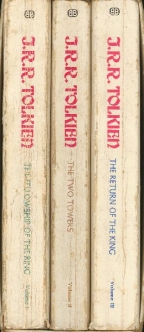 |
|
'Frodo Lives! Frodo Lives!' When I read these books I could actually pry them out of the slipcase. Now they're bloated with age and can't be excavated without ruining the cardboard. |
In case you've been living under a rock, the main progenitor of all this S&S action is J. R. R. Tolkien's 'Lord of the Rings'. Even if you closed your eyes in the bookstore, the chances are that you'd blunder into a standee display for something associated with this work. There's a reason that Tolkien's world holds its appeal after all these years, and it's not just the fine movie adaptation. In Sam and Frodo, Tolkien created a couple of indelible figures that stand out in humor and ease-of-reading, where the human and elven characters of his epic tend to get a bit blurry and blustery. Yes, there's the research, the made-up languages, the expansive imagination, and the prose that trends towards starchy. But when I was in what -- 8th grade -- my friends weren't driving me away from this epic by standing on opposite sides of me chanting 'Aragorn lives!' It was frickin' Frodo they were on about, the little runt that cornered Tolkien into tapping his sense of humor. The books are now ubiquitous. You will be assimilated.
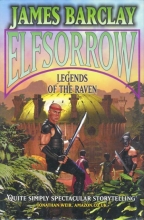 |
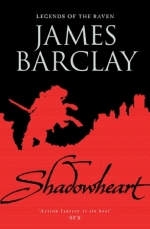 |
|
Excellent photo-realistic illustration if you like gladiator movies. |
Excellent cover that gives a bit better idea of the feel of these novels. |
On the far left, blunt-edge of the spectrum you'll find James Barclay. Barclay is a kicks-ass-and-takes-no-prisoners sort of guy. He's written four very straightforward sword and sorcery, leather diaper numbers, distinguished not by the level of violence, but rather, the level of the consequences inherent to the violence endemic to much S&S. Barclay's novels, 'Dawnthief', 'Noonshade', 'NightChild' and 'ElfSorrow' take the typical fantasy milieu, render it well and then steer it away from Ahnold Schwartzeneggar -style mayhem into Clint Eastwood-tinged tales of men, women, warriors and death. It's a subtle but distinct turn that starts in the first novels. 'Dawnthief' and 'Noonshade' are really two halves of the same story. You get a well-drawn but not utterly original collection of warriors -- your barbarian, your elf-mage, your regular mage, your big-ass warriors, and put them together in a mercenary fighting unit called the Raven. But unlike most S&S sagas, Barclay's first two novels establish that all the danger around these guys -- and the obligatory woman -- is in fact dangerous. Characters you have every reason to think you'll be reading about for the next three novels are wounded, bleed and die. These aren't just red-shirts, but fully fleshed characters. 'NightChild' spends a fair amount of time with mother and child, grief and loss, not the usual subject for your gladiatorial interests. Barclay's latest, 'ElfSorrow' takes the writing quality to a whole new level. Barclay preserves the gritty environment, and expands it into a Vietnam-like jungle populated by some of the nastiest guerrillas ever to haunt the trees. His sense of a jungle full of menace does recall a Schwartzeneggar flick this time around -- 'Predator'. But the characters are as full as ever.
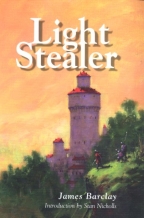 |
|
This fantasy rocks so much I had to update the column to add it. See last week's news for a large scan of this excellent cover. |
Barclay's latest from Gollancz is the forthcoming 'ShadowHeart', in which he threatens to destroy the entire fantasy world he has created with his scientifically described magic. Gollancz has changed the look of this book and is re-releasing the old novels in new, classy looking covers. But it frankly doesn't matter what's on the cover, as long as the author is Barclay. Barclay delivers classic fantasy with a classy edge. A neat introduction to Barclay's writing and his world can be found in 'Light Stealer' from PS Publishing. In this prequel to the novels, Barclay sets up a technology versus politics question and answers it with an 'Assault on Precinct 13' set-piece. This is fantasy at its most thrilling and its most science fictional. Barclay's magic is so advanced it appear indistinguishable from technology. If you have any curiousity about Barclay, here's a great way to satisfy it. I suspect that this novella will sell out fast, so I'd recommend ordering it up soon.
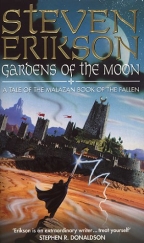 |
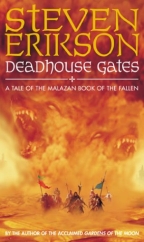 |
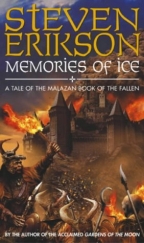 |
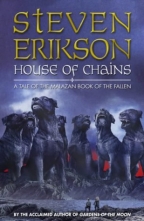 |
One pretty big step to the right of Barclay is Steven Erikson, whose Tales of the Malazan Book of the Fallen comprise a hefty bit of steady-eddy fantasy with a thick veneer of quality. Yes, I'll cop to NEVER HAVING READ a single volume of the four -- so far -- books. All I've read is 'Blood Follows', one of the most popular of the PS Publishing titles, set in the same fantasy world. And what a wonderful world it is! Erikson works in the one hundred percent solid center of fantasy -- warriors, cities, pretty low-tech science but fairly high-tech magic. What sets his world apart from the dross is Erikson's wonderful touch in integrating supernatural menace and creations into a rather urban-seeming world. He also unfurls his world in a careful, dense prose style that gives readers the impression that the clacks of the typewriter are echoing somewhere in one of his luxuriantly described cities. In this respect, he's very much like China Mieville, and my take is that readers who enjoy Mieville's milieu would also enjoy Erikson's more traditional fantasy, as it is wrapped in a very similar atmosphere.
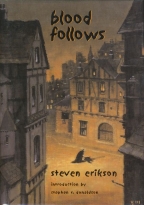 |
|
Evidently this was a popular title for PS Publishing. A sequel is slated for later this year. |
If you're lucky, you can scare up a copy of 'Blood Follows', or spring quickly for the PS publishing follow-up to this title, 'The Healthy Dead'. Once you've got a taste of Erikson's dense but enjoyable writing style, you'll find yourself ordering his entire series. Alas, if you are in the US, you'll have to do so online, and probably using a search engine, as the novels have never made it to the US. It's worth the trouble.
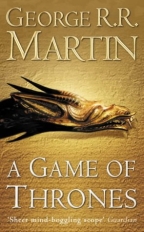 |
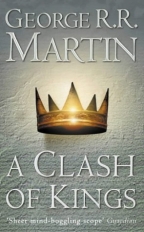 |
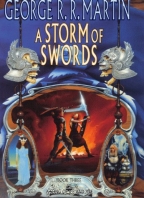 |
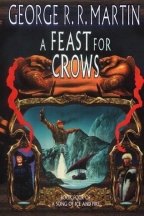 |
George R. R. Martin started his career in science fiction and horror. I have an ancient UK paperback of his collection of short stories, 'Songs the Dead Men Sing', filled with 80's horror. He's written science fiction and had the unpleasant experience of seeing it adapted into one of the worst SF movies that may ever go into your eye sockets. Vampire novels ('Fevre Dream'), rock and roll horror ('The Armageddon Rag'), and TV-series girly fantasy ('Beauty and the Beast') round out the resume. Where else to go but epic fantasy? Big screen, big selling, 'The Song of Ice and Fire' has its own Amazon.com Store, and thousands of readers slavering away to read the epic adventures. It's dense -- but not quite so dense as Erikson -- and complex, filled with characters of so many mixed motivations that almost as many swords end up in backs as they do in the guts. Readers don't really need me to recommend this, but those who enjoy these sagas will definitely want to look at Erikson's books to fill in the long blank spaces between releases of Martin's back-breaking, tree-shredding book-bricks.
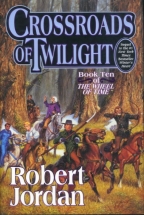 |
|
A man may be holding the weapon but the women wear the pants in this ambitious series about psychic empires and supernatural enemies. |
Still got that rock handy to protect you from the big bad forces of Commerce, er evil? Well, you'll keep it handy if you want to avoid the most successful American fantasist, Robert Jordan. I'd done so for years, but finally, offered the chance to interview him, I anted up and read his latest, 'Crossroads of Twilight', along with summaries of the runners-up. Now this isn't the recommended way to experience this living giant of fantasy. But Jordan is a good break point from the traditional Tolkien-rip offs that share the shelves with him. Jordan is up to something considerably different from Tolkien. He has an equally huge cast of characters, but he spends a lot more time with each character, giving them a depth and identifiability that is not present in Tolkien's more historically-oriented work. Jordan eschews the high-falutin' sound of fantasy, and rolls out his books like page turning bestsellers. But his setup is considerably more ambitious and complex than the usual S&S, and rather different. Yes, you'll get your armies clashing on the plains of night, and you'll get some nasty monsters and power-grabbing magicians. But you'll get a huge slab of post-feminist fantasy reality, a world in which the feminist revolution of the last two centuries is a distant memory. His world is constructed with the rigor of a science fiction series, his magic is technological enough to have gadgets.
With Jordan however, know in advance that you're making an investment. If you read the first novel and like it -- chance are you will -- then you've got, depending upon your viewpoint, either ten or more novels of pure pleasure ahead, or a three book story stretched out over far too many books. I tended to enjoy Jordan's characters, and wasn't too concerned about the lack of thunderingly-paced battles. To my mind, he seemed best at the atmospheric touches, especially when rendering the eerie environment of a city under the influence of a very nasty something. He writes with the same kind of pull exerted by good horror writers, using a similar sense of escalating menace and release. If you're a fast reader who loves a long bestseller-style story, then Jordan's definitely a writer you should seek out. Remember, the pleasure is the journey, not the destination. Especially in a series this long. With all this wind-up, arrival at the destination may cause a few million readers to experience rapture as they ascend into Jordan's created reality. Good thing they don't read and drive. For the most part.
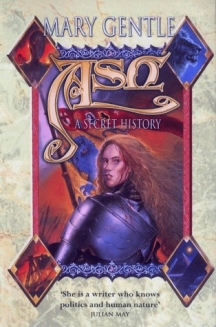 |
|
This edition of 'Ash' has the feel of a compellingly complex textbook. |
They aren't quite dropping Mary Gentle books from the ceiling in front of as you enter the bookstore, but they're not hard to find. I've only read 'Ash: A Secret History', and it really impressed me. There are lots of reasons it doesn't belong in this particular fantasy list, and that's one of the reasons that it's one of my favorite fantasies. Gentle does a number of interesting things in this novel. While I've mentioned this before, it bears repeating: buy this book in the single-volume format from the UK, not the four-paperback set available in the US. It will make an enormous difference in the quality of your reading experience, and the cost is comparable. That said, 'Ash' combine aspects of meta-fiction, science fiction, alternate history and deeply researched medieval warfare to create an environment so detailed and so vivid that reading this feels like spending a long dark winter camped in the snow. That's a good thing. You'll get all the familiar icons of fantasy fiction -- well, most of them -- all re-imagined so as to seem utterly new. Some readers may find Gentle's book just a little too detailed. Or so you might think upon seeing the page count. But once you yield to her vision, you can see why she was willing to go back and add a novella for the 'Worlds That Weren't' anthology. She states that she thought she'd never do so, but you'll be glad she did.
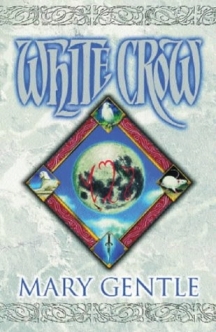 |
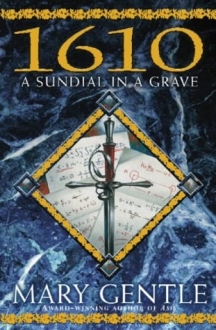 |
|
On April 10, 2003, readers will be able to get an omnibus edition of Gentle's White Crow stories, with three long works and connected short fiction. It sounds like the superior way to experience these books. |
Gentle's newest appears to be another entry in her 'Altered History' style. Demons and visions of the future make for interesting times for Valhentin Rochefort. |
Victor Gollancz, evidently plaed with the sales of the full-size edition of 'Ash' is plumping for two more huge volumes in the future. Next month we'll see an omnibus edition of the White Crow novels, including in one 560 page volume, 'Rats and Gargoyles', 'Th Architecture of Desire', 'Left to His Own Devicves' and some connected short fiction. Including all this in one huge book seems like a gret idea to me. In October, at a slim and trim 488 pages, expect '1610 A Sundial in a Grave', another bit of Gentle's Altered History. Valhentin Rochefort is a duellist and a fallen aristocrat who enters some Gentle-tinged regions of history where ships have "demons" and visions of the future probably seem rather more interesting from the current perspective.
 |
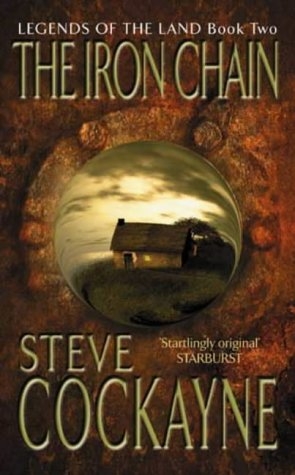 |
|
This demure looking novel would sit fine between Anne Tyler and T. C. Boyle trade paperbacks. |
I MUST HAVE FOIL! Sales will treble with foil on the cover! |
From the outside, it might seem that Steve Cockayne's 'Wanderers and Islanders: Legends of the Land Book One' is yet another of the bazillions of updated Tolkien rip-offs that litter the shelves but pull in the bucks. Once you actually start reading the novel, you'll find something distinctly different. Cockayne has a light, realistic touch, and it makes everything old seem new again. Th wizard has been downsized, and he's looking for work. You get a haunted house, a boy on a quest and something called the Multiple Empathy Engine. Cockayne adroitly keeps some very interesting plot strands aloft and when he whips them together it all seems like magic. The book is positively tiny, and yet Cockayne really gets the sense of an entire world, one that requires no explanation since it simply exists. The novel is written artfully enough that it could sit fine on a table full of meaningful trade paperbacks about contemporary issues and hold its ground. Cockayne has had a new novel released without even a whisper to the public -- like myself -- that has been awaiting it. 'The Iron Chain' is still awaiting a review or even a bit of a plot summary over at Amazon.co.uk, in spite of having been on release for over a month. I hope that the lack of publicity doesn't hurt Cockayne's writing career. I ordered this book as soon as I saw it existed. If you're buying the first, I'd suggest you buy the second. Even though the first ends on no cliffhanger, and in deed seems fairly self contained, once you enjoy Cockayne's vision and prose, you'll definitely want to look at the next installment.
Like George R. R. Martin, Mark Chadbourn comes from a solid horror background. But he really began to shine as a novelist when he took up a series of what could only be called contemporary fantasies. 'World's End', 'Darkest Hour' and 'Always Forever' comprise the 'World's End Trilogy', in which, at the turn of the century, science begins to break down and the old magic comes back to rule the land. You get the full-blown Kingdoms of Elfin, in all their hallucinogenic splendor, with some of the nastiest elves you've ever wished you hadn't met. Well, as it happens, they're pretty entertaining characters. Our human heroes nicely detailed, easily differentiated, and not all nice or nasty. The plot will be familiar to any games player or indeed any fantasy reader -- gather some items of power before the big blowdown.
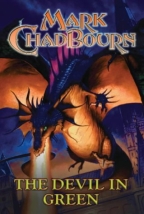 |
|
Looks like the dragons are still around in the first novel set in Chadbourn's post-mythocalyptic world. |
But Chadbourn deploys people you care about in a familiar landscape overlaid with well-turned incarnations of heavily researched folkloric beings. Chadbourn is also no stranger to the Fortean Times, so this is a rather Fortean apocalypse, as all those critters you knew were never going to get photographed make an appearance in the flesh. Like Jordan, Chadbourn writes with the pull of pulse-pounding horror. I was rather impressed when his PS Publishing novella, titled 'The Faerie Feller's Master-Stroke', and based on the famous painting, turned out to have nothing to do with the series. It was a nice piece of very different fiction. I was impressed that having started a story arc in a stated trilogy, Chadbourn finished it without increasing bloat, and nicely resolved the story line. I was also rather sad to see an interesting world go to waste. No chance of that, eh? There's a new novel out, with new characters who attempt to eke out a life in a world still going over to magic. The plot sounds intriguing enough to have me on board immediately, with Knights Templar making their appearance. OK, I'm a sucker for Knights Templar.
 |
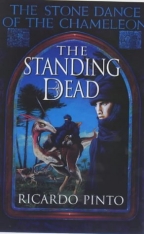 |
|
Jim Burns can be counted on to turn in a fine illustration that actually portrays events in the novel. |
In spite of the dino-style monsters on the cover, it's going to be a while before I get round to reading this novel. |
In my desire to offer full coverage of contemporary fantasy -- or at least as close to full coverage of contemporary fantasy as you're going to get out of The Agony Column, I finally got round to reading a book I'd bought about three years ago, Ricardo Pinto's (get ready for a mouthful) 'The Chosen: Book One of The Stone Dance of the Chameleon Trilogy'. At the time I bought it, I loaned it to a friend, who told me it ended on a real cliffhanger. That kind of thing really annoys me, so I waited until book two, 'The Standing Dead'. Pinto is clearly capable of some gorgeous writing, and has envisioned his world down to the smallest detail. However, he unloads all of those details upon the reader, and unless you really, really enjoy reading about people who get dressed in very elaborate costumes then traipse across a well-imagined landscape feeling very, very bad about themselves, I'd suggest you steer clear. There's a very typical fantasy plot in here about a son who blah blah and the aristocratic father blah blah and jeez, don't these people ever lighten up? No, they don't. And they take a big chunk of pages not to lighten up. Now, some readers will find themselves enjoying the lush descriptions and the angsty days and nights. When the cliffhanger finally came, I let it swing in the wind. Though I actually bought the second novel in a UK hardcover (with another nice Jim Burns cover), I certainly haven't started it and don't think I'll be finding the time to do so soon, especially since I'm told that it too ends in another cliffhanger. But with well-developed characters I just hated to hate, all I'm hearing is the whoosh of the wind.
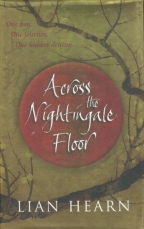 |
|
I finally made myself read this novel and quite enjoyed it. Apparently it caused quite a stir as it was published under a pseudonym with some aspirations to compete with Moby Book. |
With all this Anglo-Saxon fantasy, it's no surprise that an enterprising author would try to offer a Japanese spin. I really enjoyed Aussie children's author Gillian Rubenstein's 'Tales of the Otori: Book One, Across the Nightingale Floor', written under the pen name Lian Hearn. It was simple, it very slick, the prose was sparse and occasionally beautiful. The supernatural spin behind the story was very well handled, and the collection of powers slowly learned by the young protagonist is fascinating and different. I must admit that I had to make myself read this novel, but when I finally got round to it, I was pleasantly surprised, as opposed to chafingly annoyed. The plot is not the typical Generic Celtic Fantasy plot. But it is a typical oriental fantasy plot. No matter, because I liked the characters, and I'd be happy to go back and visit them in a heartbeat. Like many readers, I suppose my main complaint was that Hearn sets her story in a place very much like Japan, when with a little effort, it could have been Japan. Well, so there's something imperfect about the book. It's really very appealing and low maintenance, not the usual standard opening shot in a fantasy series. I quite enjoyed it, and think most readers would as well.
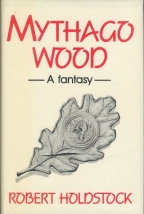 |
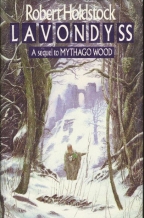 |
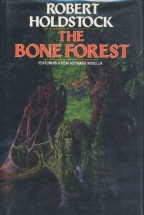 |
|
Robert Holdstock exists in a quantum state, on both sides of this artificial spectrum. But not matter where you place him, from the solid standard 'hard fantasy' to the weirdest works of the imagination, he's definitely an important presence in the world of fantasy fiction. If you haven't read 'Mythago Wood' and its sequels, including 'Lavondyss', 'The Bone Forest', 'The Hollowing', and 'Gate of Horn, Gate of Ivory', then you probably want to consider running out and buying them immediately. They start out in Ryhope Wood, a bit of primeval forest in a remote corner of Herefordshire. There, the myth imagoes -- mythagoes -- of ancient warriors come to life to play out parts from the Jungian unconscious underworld of ancient legends. Reading like a combination of Bullfinch's mythology and a post-modern hallucinatory binge, the 'Mythago Wood' novels set a new and very high standard for fantasy quest fiction.
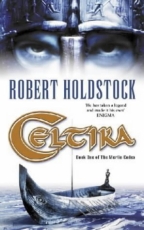 |
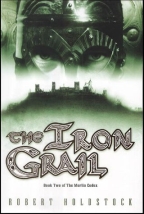 |
|
This novel is now available from Tor domestically. |
The sequel is out only in the UK, from Earthlight, a great imprint. |
The new novels comprising a new series are finally starting to trickle over stateside. Tor has finally released 'The Merlin Codex: Celtika', Holdstock's attempt to re-create the Generic Celtic Fantasy in his own unique style. Here we have the story told more from the Archetype's point of view. If you snap up 'Celtika' and gobble it down, then 'The Iron Grail' is your next Internet order from the UK. Earthlight is doing a bang-up job packaging these novels, good enough that Tor is using the same design stateside. You'll probably get more out of the books in 'The Merlin Codex', which feature Jason of the Argonauts and Merlin together, if you've read 'Mythago Wood' and its sequels. You'll have to go abroad (or on the Internet) to find them. It's worth the trip.
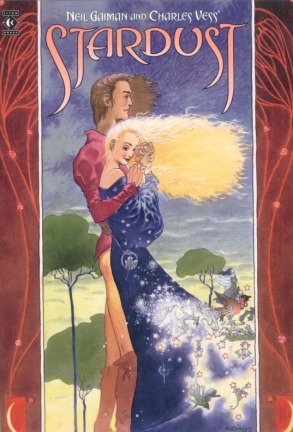 |
|
This classic, classy fantasy is Neil Gaiman's best work yet. |
Neil Gaiman is well known for his very non-traditional fantasy from last year, 'American Gods'. I dare say you might have bumped into the standee at the bookstore had you been blindfolded in the proper interval. But it's not really applicable to the type of fantasy I'm discussing today. However, his previous novel, 'Stardust' is very applicable, being a typical quest novel, and much, much better than 'American Gods', which is a fairly difficult feat. 'Stardust', hover, struck this reader as near perfect. It's compact and not a word is wasted as the young hero steps over a wall into a realm of fantasy. The real delight in this tale is Gaiman's precise, humorous prose, which shines on every page. It enables him to create memorable characters, grippingly realistic evocations of fantastic events and tell the tale of the traditional fantasy quest with verve and style. His other work verges on fantasy and uses fantasy elements, but 'Stardust', an utterly traditional fantasy, is Gaiman's best work so far.
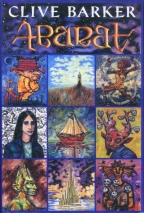 |
|
When it finally came out, it took me forever to get round to reading it, and damn if I didn't like it. 'Abarat' is nicely written and reads faster than you expect it to. Beautiful book. Buy it even if you don't plan on reading it, it's that nice. Then read it and find yourself saying 'Hell, that ain't so bad -- it's good!' |
Clive Barker has been threatening to write 'Abarat' for a long time. I was beginning to think that nothing would ever come of this project until late last year when the first of four novels came out in hardcover. It was a beautiful, expensive bit of printed art -- some 100 paintings, full color, heavy stock, glossy pages. Barker's paintings range between garish and beautiful. But it was really long -- 350+ pages and seemed like it might be pretty uninteresting. When I finally got round to reading it, I was shocked to find out that it was as good as 'The Thief of Always', from which it liberally and ironically steals quite a bit. This time around, in an inversion of the traditional fantasy plot, it's a young girl who gets swept away to the archipelago of Abarat, there to meet a bevy of weird beings some who help and some who hinder her quest. The model here is more 'The Wizard of Oz' than 'The Lord of the Rings', but Barker has a great good time with it and if you liked 'The Thief of Always', you're going to like 'Abarat' as well. Once again, as with Tolkien, it comes down to characters. Candy is not a Weasley clone, not an annoying teenager who always knows the answers, or is always complaining. John Mischief, the character with eight other "Johns" growing from horns on his head is also enjoyable. It makes the book zip by a lot faster than the reader will expect, since every plot thread offers up someone we want to be with. The ending offers enough resolution to be satisfying, and enough left unsaid to make the next installment something to look forward to. It's certainly a pretty long journey from 'The Lord of the Rings', but we've not even gone all the way.
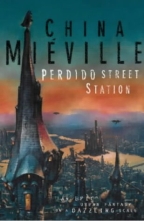 |
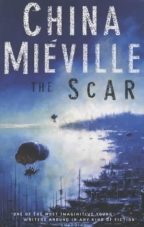 |
|
Credit where credit is due -- Edward Millar's evocative covers give Mieville's novels a feel of quality. |
Mieville matches the quality of the covers with the quality of his prose. |
In many ways, to this reader, China Mieville is doing what I'd hoped Barker would do shortly after first reading 'The Books of Blood'. Mieville writes incredibly detailed fantasy set up in worlds that are nothing like the standard elves'n'dwarves'n'swords worlds we've grown accustomed to. Mieville is setting a new standard, one that will inevitably be aped but never duplicated. In 'Perdido Street Station' and 'The Scar', he's created a complex world peopled with bizarre and grotesque creatures. One aspect of Mieville's vision that certainly stands out and tends to polarize the readers is his ability to create sympathetic but (to some) horribly monsterific creatures who are so grotesque as to be off-putting. But don't let those doubters stir your opinion. The power of Mieville's vision is that he can create a world that is so different from ours that even good looks very, very different. But it's more than just his ability to conjure visions. Mieville displays skills across the entire spectrum of writing. He'll write a scene in memorable prose, then deftly sketch a character that will touch the emotions of all but the dead. His plots are complex, and he manages to up the ante of awe, as long as readers don't spend too much time looking at the dust jacket notes. As I read both books, I'd come across scenes to which I'd literally shout, "It can't get much bigger, much better, much more imaginative than this!" A few pages later, Mieville would manage the difficult feat of topping himself. Mieville is the guy who thus far lives up to the hype.
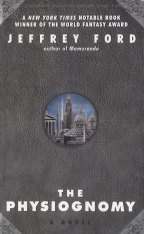 |
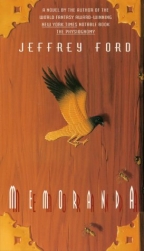 |
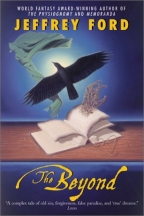 |
It's a trilogy. There are three books set in a world you've never seen and won't see. There is a protagonist, who is changed out for another partway through. There are winged demons, castles and magicians of a sort. But all those little bits are put together so imaginatively, so weirdly, so originally and with so much that's never been in anything remotely resembling a traditional fantasy that Jeffrey Ford's 'Physiognomist trilogy seems to have been beamed in from a parallel universe. The books are titled 'The Physiognomy', 'Memoranda', and 'The Beyond'. Ford writes in clear, straight-to-your-heart prose as he examines the predicament of Cley, once a master, now an outcast from The Well-Built City. Nothing is at it seems in these novels, which can often spell trouble. In Ford's novels it means that the reader is in for a delightfully accessible feat of creation that is hard to believe could be created even as you read the words on the printed page. Ford is closer to Kafka than Tolkien, but this is a Kafka with his mind on fire, filled with ideas from the worlds of memory castles and theoretical cybernetics with occasional bits of Grand Guignol horror. But there is a man, a journey, an outcome; another journey, something not quite a man; an unexpected outcome. Ford is a master at building the bridge over the chasm one brick at a time. Each word you read seems to be set solidly in midair in a feat of continuous creation. As you journey to the far end of the fantasy rainbow make sure to stop by Ford's very original vision. Nothing can match it, nothing can replace it. It's familiar and vivid yet strange and unreal. It's fantasy, pure, but never, ever simple. Don't stop with the fantasy however; 'The Portrait of Mrs. Charbuque' is an outstanding novel, easily one of the best of the year of its release.
 |
|
Luxurious language highlights VanderMeer's bio-tech science fantasy. Echoes of Greek, Christian and scientific mythology slide across the greasy oceans he finds within. |
Falling into the farthest realms of fantasy, reaching into the arms of science fiction and beyond comes Jeff VanderMeer. His 'Cities of Saints and Madmen' sets the standard for meta-fictional, non-traditional fantasy. His latest novel 'Veniss Underground' strides confidently into Jack Vance territory, taking science to a Clarkian extreme so that it is virtually indistinguishable from magic, and sending his hero out on a fantasy quest into a strange and hostile world to rescue the fair maiden. Like much fantasy, the plot fits rather neatly in a niche. But like only the best fantasy, VanderMeer uses some written special effects that will blow reader's brains out of the back of their heads and into the next room. His language is utterly gorgeous, on par with China Mieville, and his characters are grotesque but compelling. His ability to conjure the strangeness of a transformed future earth is reminiscent of William Hope Hodgson, but his sensibility is uniquely his own. He takes the biotech revolution and runs with it into the next world. All this would be quite enough, thankyouverymuch, but it's not enough for VanderMeer. He also manages to seamlessly weave in aspects of Christian religion, Greek mythology and oozing 'Alien' like landscapes. Yet, there it is -- the boy rescues the girl from the monster. And 'Ulysses' is a day in the life. VanderMeer's 'Veniss Underground' is a fantasy bio-engineered for enjoyment.
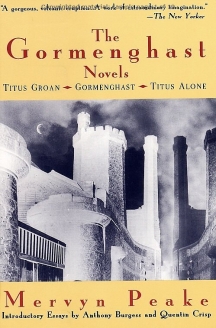 |
|
JK Potter provides the cover on this omnibus edition of Peake's trilogy. Check out his children's books -- they're as good as 'Gormenghast'. |
Having run the gamut of weirdness only takes the reader back 60 years to the other post-war fantasy masterpiece, 'Gormenghast'. While Tolkien seems to influence the left half of the spectrum, Peake's masterpiece bends the right side, from Ricardo Pinto through China Mieville and Jeff VanderMeer. Peake's tale is set in an enormous castle where the inhabitants leads pointless lives following rules that make no sense whatsoever. Into the ritual, into the tedium come a baby, Titus Groan; and a twisted teenager, Steerpike. The two of them will transform the lives of the inhabitants. Peake's strengths are his lovely prose and his sense of humor. His Dickensian plot and characters seem firmly grounded in a reality that does not exist on this earth. The lives they lead are absurd, touching, beautiful and ominous. Unlike, 'The Lord of the Rings', 'Gormenghast' never got the full attention of the media. This is surely in part because it was unfinished; the third book is merely a sketch of what could have been. 'Gormenghast' lacks the supernatural elements and the simplistic elements of action that make such great set-pieces in the LOTR movies. Instead we get incredible moments of character insight; the reveries of the main characters while sitting around a table comprise one of the most thrilling sequences of prose in the entire canon of fantasy. This is a reader's and writer's series. The pleasures awaiting you in Peake's prose are pure and refined, the distillation of human love, human frailty, human imagination untainted by anything other than Peake's vision. Forget all that Celtic lore. This is what fantasy is all about.
Yes, my examination of fantasy has left a number of old chestnuts out. Primary among them would be Robert E. Howard, who pretty much defined Sword and Sorcery, and writers of imagination like Fritz Leiber, whose Fafhrd and the Grey Mouser series lit up my early fantasy reading life, while Michael Moorcock's eternal champion books, in particular, the Elric novels, remain seated in my limbic system as unforgettable reading experiences. But obviously one can now find a whole new generation of fantasy, stuff that's not embarrassing. You can accommodate a range of tastes in a single small diaper-wearin' subgenre. You can escape this world repeatedly, stopping by long enough to report for work and pay the bills. Your time away won't be wasted. As you build these worlds in your brain with the help of a variety of talented authors, you'll be re-building your world, this world in your brain. It will be better, and you will be stronger. You'll understand the limits and how to hack your way through them. You want to re-imagine your life into something better? You want to have your fantasies come to life? You'll need a little help in the fantasy world-building department, and these writers can help you re-imagine your reality.
Thanks,
Rick Kleffel